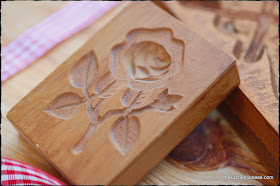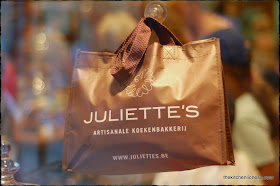This is
part II of my
Bruges mini-series and this post is all about that famous
Speculoos in Flemish and
Speculaas in Dutch, whichever way you pronounce it, these buttery, short crust cookies that are related to the gingerbread family of cookies, are replete with warming spices such as cinnamon, ginger and cloves. They continue to be a Flemish and Dutch favorite that has captured the fancy of cookie lovers all over the world.
While we visited Bruges a few days ago, we marveled not only at unbelievably delicious local foods and chocolates but we were also lucky enough to sample a variety of these iconic cookies that often come in the shape of picturesque
windmills - when we returned home, I tried to re-create these lovely cookies using some of the
specialty wooden molds from my collection.
This mold depicts a lovely rose and was given to me a few years ago - it is from an antique store in Bavaria.
This one was made from a different type of wood and it depicts a bearded fellow...
... when you look closely you can see that the depth of the carvings differs from mold to mold. As a general rule, the more detail there is, the clearer the outlines of the final cookies will be - although it also depends on the kind of recipe that you use for your cookies and whether the dough was chilled properly.
If you are a fan of what is possibly Belgium´s favorite cookie and of all things cookie and speculoos-related, Bruges is the place to visit. Speculoos cookies are actually sold in the US by a famous Begian company as
Biscoff cookies.
When you are in Bruges, speculoos cookies are sold at every bakery and some specialty baking shops also carry the
traditional wooden baking molds to make these wonderful cookies at home.
One of the most famous bakeries where the speculoos cookies are sold is
“Juliette´s”, a bakery run by cookie expert and shop owner
Brenda Keirsebilck.
In her iconic, artisanal shop that emanates mouth-watering wafts of almond, sugar, spice and really everything nice, you can find many delicious and decadent treats such as the
custom made speculoos - this one features the
Belfry of Bruges, the medieval bell tower in the historical centre of Bruges, it is one of the city's most prominent symbols. But there are also birthday and graduation wish hearts, baked invitations and depending on the season, Saint Nicholas´or Easter bunnies.
Or these meringues with different flavors such as “
Natuur” (plain) or…
…or “
Cocos” (coconut) and “
Pistache and Rozenwater” (pistachio and rosewater)…
…or “
Mojito”…
…or "
Koffie met Hazelnoot" (coffee and hazelnut) and "
Nougat" (nougat)...
…or those lovely meringues that are pink-hued and “
Cuberdon-flavored”. Cuberdons are raspberry-flavored and purple, though more recently differently colored variants have been available as well. The outside is relatively hard, whereas the inside is gelatinous. Cuberdons can only be kept for about three weeks, after that the inside begins to crystallize. That is the reason why cuberdons are not exported outside of Belgium - they are considered to be a regional Belgian product.
Speculoos used to be Christmas-time only cookies, but in the last couple of years, there has been a real rebirth regarding these special cookies.
Brenda Keirseblick is also the author of “
Juliette’s Speculoos: Recipes from Bruges’ most charming biscuit bakery”.
You can sample not only those lovely and delicate meringues but also cupcakes with various toppings, giant cookies and squares of speculoos with delicious, marzipan-filled centers, some dipped in chocolate, others flecked with toasted almond slivers, the combinations are absolutely delightful. I really liked these "
Hasseltse zachte Speculoos" - soft speculoos that take their name from "
Hasselt", a Belgian city and capital of the Flemish province of Limburg.
There is even an on-site made
speculoos spread (also known as "speculoos or biscoof pasta or spread") that is delicious on hot buttered toast or wonderful for baking cookies, cupcakes or cakes.
And last but not least, you can also buy the most tender of "
Nougat" (nougat) at Juliette`s.
In order to re-create a bit of the charm of this lovely artisinal bakery at home, I tried out a few recipes for Speculoos, with and without almonds, with more or less generous amounts of spices and finally settled on this spicy version - the smell that eminates from the kitchen while these are baking is nothing short of wonderful - even in August warm spices have a certain magic to them.
Speculoos Cookies
Ingredients for the cookies
- 250 grams white spelt flour (you can substitute wheat flour/AP flour instead)
- 2 tsp freshly ground ginger
- ¾ tsp freshly ground cloves
- 1 tsp freshly ground cinnamon
- 1/2 tsp freshly ground nutmeg
- ½ tsp fine sea salt
- ½ tsp baking soda
- 110 grams unsalted butter
- 85 grams soft brown sugar (you can use soft light or dark brown sugar)
- 2 tsps pure vanilla sugar
- 1 egg (S), organic or free range whenever possible
- 60 ml clear honey
- 1 tbsp molasses
Preparation of the Cookies
- In a large bowl, sift together the flour, spices, salt and baking soda.
- In a separate bowl, beat the butter until creamy. Add the sugar and vanilla sugar and continue to beat until soft and fluffy.
- Add the egg and mix well.
- Then add the honey and molasses.
- Add the flour mixture to the butter and mix until you have a smooth dough - it will be soft.
- Wrap the dough in saran wrap and refrigerate overnight.
- The following day, preheat the oven to 175 degrees Celsius and line two baking sheets with parchment paper.
- Take slices of the chilled dough and place on a lightly floured surface.
- Roll out to around 1 1/2cm thick, then dust the top lightly with flour and press the molds into the dough - or use cookie cutters to cut out your favorite shapes.
- Transfer the cookies to the prepared baking sheets.
- Bake the cookies for about 10 to 12 minutes or until they are just golden at the edges (you may need more or less time depending on the size of your cookies).
- When baked, allow the speculoos to cool for a minute or so and then transfer to a wire rack to cool completely.

This is just one recipe for Speculoos - there are countless other ones, dark ones, lemon ones, vanilla ones, with or without almonds, the possibilities and the recipes seem to be endless but no matter which recipe you try, now or later during the year, Speculoos cookies are always delicious and pretty and worth the bit of extra work.
Let me be honest, it does take a bit of practice to work with these specialty molds and it is a tad time consuming...
...but definitely worth it (once in a while) and no matter which recipe you try, you should always make sure to use the freshest of spices you can. And as I already mentioned above, if you cannot find or own these
specialty wooden cookie molds, you can also use cookie cutters or even a cookie press - speculoos cookies will always taste heavenly no matter what shape they are!





























































